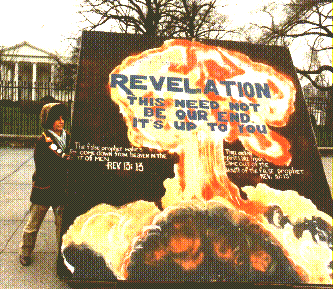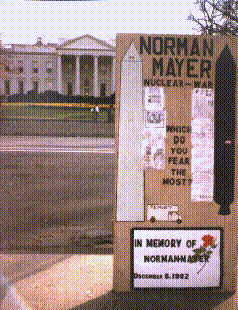Judge Lifts White House Picket Rules
The Washington Times
THURSDAY, MAY 5, 1983
By David Sellers
Washington Times Staff A federal judge yesterday struck down new National Park Service regulations that limit the activities allowed as part of demonstrations on the sidewalk in front of the White House.
A federal judge yesterday struck down new National Park Service regulations that limit the activities allowed as part of demonstrations on the sidewalk in front of the White House.
U.S. District Judge William Bryant issued a temporary restraining order, explaining that he failed to find that an emergency existed and that federal officials should have allowed a 30-day comment period on the regulations instead of putting them into effect immediately.
"I don't think there's any justification for not having that 30-day period:' Bryant said. "There's no articulated exigency."
Although there are 20 days left in the comment period, Bryant's order is good for only 10 days. Lawyers for both sides acknowledged that they may be back before the court at a later date; but they said they would try to work out any differences among themselves.
 Assistant U.S. Attorney John Bates said he was not certain whether his office would appeal Bryant's order.
Assistant U.S. Attorney John Bates said he was not certain whether his office would appeal Bryant's order.
The new regulations, implemented April 22, prohibit individuals from exhibiting placards or signs on the White House sidewalk unless the person holds them at all times.
The regulations also provide that any packages or containers put down on a sidewalk must be attended and law-enforcement officials must be permitted to search the property. The property also may not be permitted to remain on the sidewalk for more than an hour Bates argues that there are three reasons to support implementation of the regulations: security, congestion and enjoyment of the White House. Although Bates claimed that the demonstrators impede pedestrian and vehicular traffic and "limit the significance and enjoyment of the White House experience for the public:' he based most of his argument on the security concern. "These are carefully considered regulations that have a minimal impact," Rates argued. "There's no attempt to ban people from demonstrating ."
Two government witnesses who testified at yesterday's hearing, Secret Service Assistant Director Jerry Parr and U.S. Park Police Deputy Chief James Lindsey, said that recent events convinced them of the need for the regulations. Specifically, they referred to last week's explosion at Fort McNair in Southwest Washington, the bombing of the American embassy in Beirut and the incident involving Norman Mayer, who last year threatened to blow up the Washington Monument with 1,000 pounds of dynamite he said he had in his truck, Mayer was a frequent demonstrator in front of the White House.
ACLU legal director Arthur Spitzer, who represents several demon- strators including the White House Vigil for the ERA Committee, based his argument on two areas: the merits of the regulations and the method by which they were implemented.
Spitzer contended that the government had been considering the regulations for several months and that there was no emergency that Justified bypassing the 30-day comment period.
Spitzer also argued that the regular protesters, including one of his clients, Edward Saffron, who has demonstrated in front of the White House for 14 years, were mindful of the needs of the public and allow tourists to have a clear view of the White House.
"Here the First Amendment interest is paramount. It's not a privilege to use the White House sidewalk; anyone can walk there," Spitzer said.
(picture: Connie holding sign "Quick return to the White House beat". A day after a federal judge issued a temporary restraining order against enforcement of rules governing picketing at the White House, this protester arrived to carry her sign and take up a sitting position along the wall.)
The Protest Goes On
 Sympathizers with demonstrator who was slain at White House
Sympathizers with demonstrator who was slain at White House
continue their anti-nuclear vigil
Houston Chronicle March 13, 1983
BY MONA MEGALLI
United Press International
WASHINGTON -- A guard at the gate calls them the regulars. the ones who sit, stand or pace Pennsylvania Avenue nearly every day picketing the White House.
People for or against nuclear war, abortion, the Vietnam War, budget cuts, and many other issues have made the northern front of the White House their forum.
"Whatever makes the headlines one day, there's someone who comes in the next day to file for a First Amendment permit. It goes in cycles," says National Park Police spokeswoman Sandra Alley.
Some protest there for a few hours, others persist in their cause for years. Most remain anonymous. Norman Mayer didn't.
On Dec. 8, Mayer, 66, who had demonstrated daily before the White House against nuclear weapons since June 1982, besieged the Washington Monument for 10 hours before he was killed by police.
Coincidentally, nuclear warfare again was the preoccupation of the few regulars who braved a blustery Washington morning One day this month.
Through the White House fence, Concepcion Picciotto threw crumbs to the pigeons on the presidential lawn. She leaned over a large sign that warns of nuclear holocaust in red and green lettering.
Another sign read:"God Bless jelly beans and H-bombs."
Mrs. Picciotto, in a soft Latin accent, spoke of initially coming to Washington to seek justice and freedom.
"I had been on a campaign across the country and couldn't accomplish anything." she said. "I Was here all day and accomplished nothing. Now I am committed to a 24-hour vigil against nuclear weapons. I have been here for 17 months now."
Mayer used to give her a penny for each anti-nuclear pamphlet she handed out for him. Mrs. Picciotto said.
Pressed for details, she suggested that William Thomas, a fellow protester who once was Mayer's protege, could answer more questions. She said he had been on vigil for 19 months.
We walked behind an enormous sign of a mushroom cloud of eerie psychedelic hues. The sign, raised on a mobile platform, slopes to form the side of a shelter, like one-half of a peaked roof.
Thomas, 35. an articulate man with a bushy brown beard and a bad cold, lay on its floor under a quilt. Packed paper bags lined a shelf built into the shelter he has made from bits and planks of discarded wood. Every night, he said, they pack all their signs and roll their shelter farther along the sidewalk to sleep in front of the Old Executive Building.
"All sorts of people have been coming up to talk to me since Norman died," Thomas said."Before, when I started not too many People came. All I had was a filthy pair of jeans."
His clothes looked clean -- an orange down jacket brown corduroys, and wine leather boots. "Concepcion finds these," he said.
Thomas earnestly launched into a monologue for Mayer, against nuclear Warfare. He went on to explain how, by living "without accommodations." he illustrates humanity's ability to do without the possessions They use atomic warfare to protect.
Another regular, Edward Saffron. 65, bundled in blue against the cold, clear morning, said he has walked his beat for a few hours a week since May 26, 1969. The neat, open-faced man sported a blue and white muffler and a sandwich board calling for world disarmament.
He will only hand out his typed, copyrighted, five-sheet pronouncement on global survival to people who are interested. "I'm not a millionaire. I have to pay for these," he said.
"After this, I'll go home, eat something, switch on the television and take it easy. I'm here to make the White House know I am here," he said.
"We get a lot of regulars. After a while, unless they are violent, all they do is merge in the past." said J.C. Lindsey, deputy chief of Park Police Office for Operations. As long as protesters cause no trouble "they're our guests," Lindsey said.


 Sympathizers with demonstrator who was slain at White House
Sympathizers with demonstrator who was slain at White House